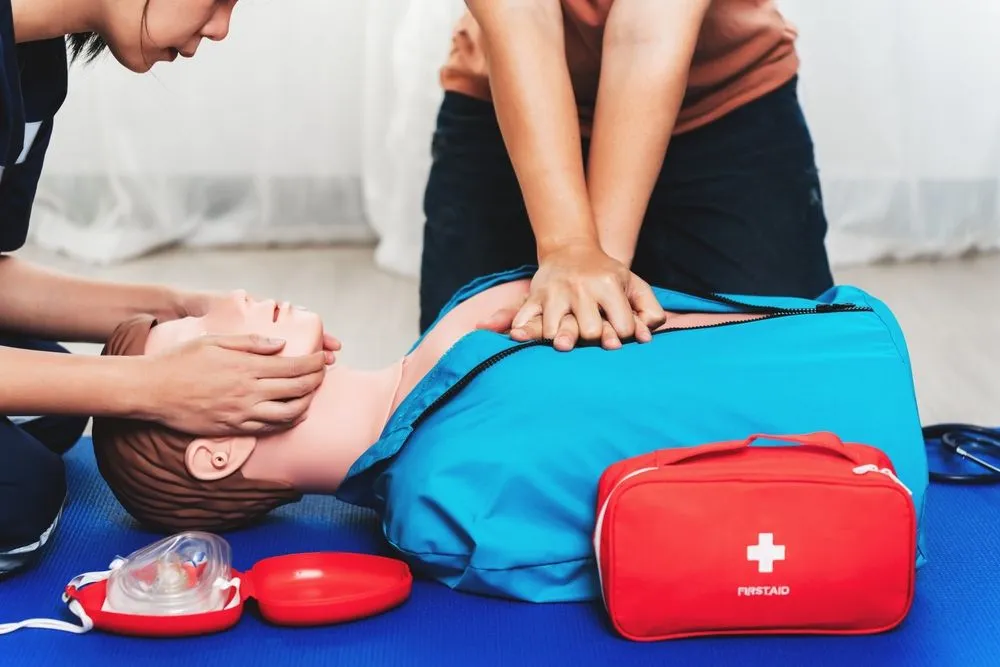Drowning emergencies happen fast, often without any warning. Knowing what to do in those critical moments could mean the difference between life and death. Whether you’re hanging out at the pool, the beach, or even a lake, it’s important to stay calm, act quickly, and follow these drowning first aid steps..
How to Spot a Drowning Emergency
Drowning doesn’t look like what you see in the movies. It’s usually silent and subtle, while in most cases a person maybe calling out for help or splashing in a state of panic, there have been cases where the person may not even be able to call for help. Here are the common signs to watch for:
- Head low in the water, with their mouth open or tilted back
- Gasping or struggling to breathe
- Weak or no movement-sometimes they just float motionless
- Trying to “climb” in the water but not making any progress
If you see any of these signs, don’t wait-take action immediately.
Step 1: Keep Yourself Safe
Before diving in, make sure you’re not putting yourself in danger. If the water looks rough or risky, use a flotation device or a long pole to reach them. Enter the water only if you’re sure you can safely bring them back.
Step 2: Get the Person Out of the Water
If it’s safe, remove the person from the water as quickly as possible. Time is critical when someone isn’t breathing. Lay them flat on their back on a solid surface and clear their airway.
Step 3: Check for Breathing and Pulse
- Breathing: Place your ear close to their mouth and nose to listen for breath sounds. Watch their chest for movement.
- Pulse: Check for a pulse by placing two fingers on their neck, just under the jawline.
If a person rescued from drowning is not breathing, you’ll need to act fast.
Step 4: Give 5 Rescue Breaths First
Call emergency services (999 UK, 112 Europe, 911 US) before taking action.
For drowning victims, oxygen is often the biggest issue. Unlike other emergencies, drowning first aid starts with 5 rescue breaths before moving to chest compressions:
- Tilt their head back slightly to open their airway.
- Pinch their nose shut and cover their mouth with yours to form a seal.
- Blow in gently—just enough to make the chest rise. Repeat 5 times.
This step is crucial because it helps deliver much-needed oxygen to their lungs.
Step 5: Start CPR if There’s Still No Breathing
If the person doesn’t respond after the 5 rescue breaths, follow these CPR steps:
- Start chest compressions:
Place one hand over the other in the center of their chest.
Push hard and fast (about 2 inches deep) at a rate of 100–120 compressions per minute. - Alternate 30 chest compressions with 2 rescue breaths.
- Continue until the person starts breathing or emergency services arrive.
This combination of rescue breaths and compressions is essential for CPR in drowning emergencies.
Step 6: Prevent Hypothermia and Monitor Closely
If they regain consciousness, lay them on their side (recovery position) to keep their airway open, especially if they might vomit.
- If they are cold, cover them with a towel or blanket to prevent hypothermia, but avoid overheating.
- Stay with them until medical help arrives.
Step 7: Always Get Medical Help
Even if the person seems fine afterward, take them to the hospital. Drowning victims can develop secondary drowning, where fluid builds up in the lungs hours later. This condition can be life-threatening if not treated quickly.

Want to learn more about First Aid for drowning? Our First Aid courses offer complete training to help you handle critical situations. Whether you want to improve your skills or workplace safety, these courses help build confidence and expertise. View our Emergency First Aid at Work (EFAW) and Level 3 First Aid at Work courses. These courses meet the UK legal requirements and help you keep people safe.
Why 5 Rescue Breaths for Drowning Matter
In drowning cases, the lungs are not necessarily full of water, but the airway may be blocked, and the body is deprived of oxygen (hypoxia). That’s why giving 5 rescue breaths before starting chest compressions can make a huge difference—it helps oxygenate the body, increasing the chances of survival.
How to Prevent Drowning Emergencies
- Always supervise: Never leave children alone near water—not even for a few seconds.
- Learn to swim: Take swimming lessons or refresh your skills if it’s been a while.
- Use life jackets: They’re essential for boating or swimming in open water.
- Avoid alcohol near water: Alcohol impairs judgment and balance, increasing drowning risks.
- Learn CPR: Knowing how to give CPR for drowning can save lives when every second counts.
No one ever wants to face a drowning emergency, but being prepared is key. If a person rescued from drowning is not breathing, give 5 rescue breaths before starting CPR. Stay calm, act quickly, and never skip medical attention, even if the person seems okay.




